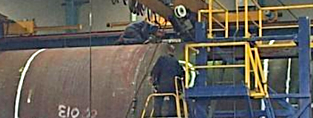
- (03) 5909 8218
- enquiry@fusionweld.com.au
Metal Heat Treatment: What is Annealing and Its Benefits?
June 5, 2015

Metallurgical science takes control of steel production by incorporating several thermal treatment stages into the fabrication of the indefatigable alloy. These intelligently integrated heat treatment processes manipulate the crystalline substructure of the tough alloy, working the metal to alter its basic structure until new properties are introduced. The annealing stage is an essential member of the heat treatment family, a high temperature ingredient in thermal alloy management that's fundamental in preparing steel for its eventual application.
There are two key scenarios where annealing comes into play. The steel alloy is cold worked and cut at the factory, moved from tool phase to work hardening machines until the metal becomes stressed and difficult to work with. A shift to an annealing oven melts and softens the alloy, thus alleviating brittleness and crystalline stress so that the part can be machined once again. In looking closer at the annealing phase, we see the steel being uniformly heated until the material reaches its upper critical temperature. The metal cools naturally, moving from glowing white hot on down to room temperature until the diffused microstructure reaches equilibrium once more. The annealing process, at least in this scenario, resets the properties of the alloy and prepares it for the cold forming stage where loads are once again introduced to the structure of the metal.
The homogeneous reformation of steel is necessary when steel is involved in cold working and machining, the work stages where internal stress are introduced into the structure of the material. Of course, the same annealing techniques are applicable when creating graded steels that are bound for their final destinations. The annealing of the steel acts as a thermal toughening technique, raising the temperature of the metal until it’s close to its melting point. The structure of the metal then transforms at a microscopic level, altering the crystalline composition of the alloy and inducing tailor-designed properties that will serve the industrial application the steel is inducted into. The process first softens the alloy, using the heat to change the metal into a ductile, more malleable form. Upon cooling, the steel recrystallizes and takes on new characteristics.
Changes made by annealing include enhanced mechanical properties and newly improved machinability attributes. The very surface and feel of the alloy is now dramatically different from before. It changes the grain size of the alloy, altering the surface to prevent cosmetic defects, including the dreaded 'orange peel' effect. Also, thanks to fine-level management of annealing temperatures, the re-crystallization of the metal is manageable to the nth degree, thus allowing the creation of coarse-surfaced steel products with carefully calculated ductility features and malleability properties.
The furnace heating and in situ cooling techniques used in industrial annealing are responsible for a significant part of the heat treatment of high-end steel. These products then move on to become structural components within civil engineering projects, the uniformly treated encasements that form weldable pressure vessels and heat exchangers, and much more. The metallurgical science seen here is key in toughening alloys for factory reworking and industrial application.
Contact Details
Fusion - Weld Engineering Pty Ltd
ABN 98 068 987619
1865 Frankston Flinders Road,
Hastings, VIC 3915
Ph: (03) 5909 8218
Optimized by NetwizardSEO.com.au
Recent Posts
- Compressed Hydrogen Storage Vessels: Material Selection, Design & Australian Standards
- Welding QA/QC in Oil & Gas Pressure Vessel Fabrication – Ensuring Code Compliance
- AS1210 vs ASME VIII Pressure Vessel Code: Key Differences for Australian Projects
- Mitigating Hydrogen-Induced Cracking in Pressure Vessels: Engineering and Material Strategies
- Storage Tank Solutions Australia: Field-Erected, Prefabricated & Self-Bunded Explained
- Reducing Environmental Risks: Self-Bunded Tanks in Australian Oil & Gas Operations
- Precision in Production: How Pressure Vessels Are Manufactured for Industrial Safety
- Shell & Tube Heat Exchangers: Improve Thermal Control & Energy Recovery in Petrochemical & Pharmaceutical Plants
- In-Service Inspection for Compressed Air Receivers for Power Plant Shutdown Prevention
- Power Plant Pipe Spooling Fabrication – Get Rapid, Code-Compliant Spools Ready for Installation
- Field Erected Tanks: Safe, Reliable On-Site Fuel Storage Solutions in Australia
- Custom Pressure Vessel Fabrication for Flammable Gases
Posts 2025
- Compressed Hydrogen Storage Vessels: Material Selection, Design & Australian Standards
- Welding QA/QC in Oil & Gas Pressure Vessel Fabrication – Ensuring Code Compliance
- View all articles…
Posts 2024
- Large Process Vessels: Optimising the Design for Maximum Efficiency [2025]
- Pressure Equipment Management System Installation: Detect Equipment Faults Early
- View all articles…
Posts 2023
- Pressure Piping System Inspection: A Gift of Safety for the Holidays
- Deaerator Inspections by Fusion-Weld Engineering and How They Reduce System Downtime
- View all articles…
Posts 2022
- How Fusion Weld Keeps Up With AS-NZS ISO 9001:2008 Standard
- Boiler Equipment Safety Inspection During the Summer Season
- View all articles…
Posts 2021
- Avoid These Factors and Practices that Contribute to Sealing Damage in Pressure Vessels
- Do's And Don'ts Of Industrial Boiler Inspection And Maintenance From Fusion-Weld
- View all articles…
Posts 2020
- What are the Risks and Hazards Involved in Pressure Vessel Equipment?
- How to Know if Your Pressure Equipment Needs Repair or Replacement?
- View all articles…
Posts 2019
- Factors that Contribute to Pressure Vessel Failure
- Pressure Vessel Regulations in Australia: What are the Mandatory Requirements?
- View all articles…
Posts 2018
- Pros and Cons of Spherical vs. Cylindrical Pressure Vessels
- What are the Different Hazard Levels in Pressure Vessels?
- View all articles…
Posts 2017
- Transportable Pressure Vessels: The Importance of Inspection and Safety Checks
- Fracture Mechanics and Stress Analysis of Cracks in Pressure Vessels
- View all articles…
Posts 2016
Posts 2015
- What Are Deaerators & Feedwater Vessels?
- Precautions and Safety for Compressed Air Receiver Vessels
- View all articles…
Posts 2014
- Demonstrating In-process Inspection Procedures
- Static Grounding Practices and Standards
- View all articles…